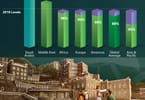AUSTRALIA (eTN) – The Royal on the Park Hotel in Brisbane, a popular four-star hotel in central Brisbane, opposite the city’s delightful Botanical Gardens, has a small marker near the top of the entrance to the hotel’s restaurant. This marker indicates the level of inundation the hotel experienced during the 1974 flood, the most severe flood event in the city’s recorded history. There is now real concern that the mark for 2011 flood may be even higher.
The floods, which have now inundated over one-third of Australia’s second largest state, an area equivalent to 150% the size of Texas in the United States (or France and Germany combined), are set to dwarf the 1974 levels. Until a few days ago, the Queensland floods had spared Brisbane, but the past two days of torrential rain throughout southeast Queensland have changed everything.
On Monday, January 10, the city of Toowoomba, 900 meters above sea level and about 90 kilometers from Brisbane, experienced what the local police chief described as a tsunami from the sky. An apocalyptic deluge turned the main commercial street of the city of 100,000 people into a raging river, which swept cars and trucks down the street in its wake. Partially through luck and mainly due to the heroic and professional actions of emergency and rescue personnel, deaths due to the Queensland floods have been kept to 10 people although over 60 people remain unaccounted for. The floods have now extended from Queensland several hundred kilometers south into coastal and tableland regions of Northern New South Wales.
Large areas of the popular tourism resort region of Queensland, the Sunshine Coast (100 kilometers north of Brisbane) have been inundated. Now the state capital, Brisbane, a city of two million people, is facing the grim prospect of as many as 9,000 properties being inundated. Flood mitigation infrastructure developed to protect Brisbane after the 1974 floods offers some hope that the extent of damage in Brisbane and surrounds may be less than feared, but the intensity of the deluge in and surrounding Brisbane has resulted in massive volumes of water cascading over dam spillways.
A few days ago, Mr. Daniel Gschwind, the Crisis Management expert from the Queensland Tourism Industry Council, was reported as estimating that the damage to the Queensland tourism industry from the floods would be in the region of $100 million dollars. With the new threats to Brisbane and to Northern NSW, a revised estimate could exceed the eventual cost by a factor of two or three. Queensland is fortunate to have some outstanding globally respected experts in the field of tourism crisis management including Professor Bruce Prideaux, Ian Kean, Professor Jeff Wilks, Dr. Brent Ritchie, and the staff of the Centre for Disaster Management at the James Cook University in Cairns. Their expertise will hopefully be employed to help in the recovery process, and there are many other tourism crisis management specialists in Australia who are willing to help.
The one bright spot in the flood crisis is that Brisbane’s international and domestic airport is expected to be operational even at the peak of the floods, which is expected to hit Brisbane on Thursday, January 13. Road routes in flood-ravaged southeast Queensland and Northern NSW are cut in many places, and travel within the Brisbane metropolitan areas is expected to be an obstacle course for the next week.
The obvious priority for Queenslanders and Australians now is rescue and relief for the victims of the floods. While fatalities have been minimized, largely due to the implementation of carefully-planned and well-executed disaster management procedures, the floods will result in many people being rendered homeless and a repair and recovery bill, which will cost government and business many billions of dollars.
After the flood waters have receded, Tourism Queensland is preparing to undertake a major campaign to encourage both domestic and international tourists to return to Queensland. The floods have spurred massive emotional and financial support for Queensland from all over Australia, and solidarity will almost certainly be a key marketing message directed at the domestic travel market. However, Tourism Queensland may have to confine one of their formerly successful marketing slogans, Queensland, “beautiful one day, perfect the next” to the dustbin of marketing history. Memories and reminders of the 2011 floods are likely to last quite a while.
The author, David Beirman, is a Senior Lecturer in Tourism at the University of Technology-Sydney.
WHAT TO TAKE AWAY FROM THIS ARTICLE:
- Flood mitigation infrastructure developed to protect Brisbane after the 1974 floods offers some hope that the extent of damage in Brisbane and surrounds may be less than feared, but the intensity of the deluge in and surrounding Brisbane has resulted in massive volumes of water cascading over dam spillways.
- The one bright spot in the flood crisis is that Brisbane's international and domestic airport is expected to be operational even at the peak of the floods, which is expected to hit Brisbane on Thursday, January 13.
- Daniel Gschwind, the Crisis Management expert from the Queensland Tourism Industry Council, was reported as estimating that the damage to the Queensland tourism industry from the floods would be in the region of $100 million dollars.






















